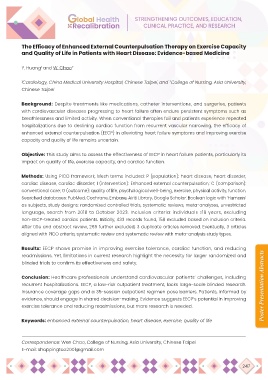Page 249 - GHR_NursingCMU2024_Final.indd
P. 249
The Efficacy of Enhanced External Counterpulsation Therapy on Exercise Capacity
and Quality of Life in Patients with Heart Disease: Evidence-based Medicine
1
Y. Huang and W. Chao 2
Cardiology, China Medical University Hospital, Chinese Taipei, and College of Nursing, Asia University,
1 2
Chinese Taipei
Background: Despite treatments like medications, catheter interventions, and surgeries, patients
with cardiovascular diseases progressing to heart failure often endure persistent symptoms such as
breathlessness and limited activity. When conventional therapies fail and patients experience repeated
hospitalizations due to declining cardiac function from recurrent vascular narrowing, the efficacy of
enhanced external counterpulsation (EECP) in alleviating heart failure symptoms and improving exercise
capacity and quality of life remains uncertain.
Objective: This study aims to assess the effectiveness of EECP in heart failure patients, particularly its
impact on quality of life, exercise capacity, and cardiac function.
Methods: Using PICO framework, Mesh terms included: P (population): heart disease, heart disorder,
cardiac disease, cardiac disorder; I (intervention): Enhanced external counterpulsation; C (comparison):
conventional care; O (outcome): quality of life, psychological well-being, exercise, physical activity, function.
Searched databases: PubMed, Cochrane, Embase, Airiti Library, Google Scholar. Boolean logic with ‘Humans’
as subjects, study designs: randomized controlled trials, systematic reviews, meta-analyses, unrestricted
language, search from 2018 to October 2023. Inclusion criteria: individuals ≥18 years, excluding
non-EECP-treated cardiac patients. Initially, 433 records found, 158 excluded based on inclusion criteria.
After title and abstract review, 269 further excluded, 3 duplicate articles removed. Eventually, 3 articles
aligned with PICO criteria, systematic review and systematic review with meta-analysis study types.
Results: EECP shows promise in improving exercise tolerance, cardiac function, and reducing
Poster Presentation Abstracts
readmissions. Yet, limitations in current research highlight the necessity for larger randomized and
blinded trials to confirm its effectiveness and safety.
Conclusion: Healthcare professionals understand cardiovascular patients’ challenges, including
recurrent hospitalizations. EECP, a low-risk outpatient treatment, lacks large-scale blinded research.
Insurance coverage gaps and a 35-session outpatient regimen pose barriers. Patients, informed by
evidence, should engage in shared decision-making. Evidence suggests EECP’s potential in improving
exercise tolerance and reducing readmissions, but more research is needed.
Keywords: enhanced external counterpulsation, heart disease, exercise, quality of life
_____________________________________________________________________________________________________
Correspondence: Wen Chao, College of Nursing, Asia University, Chinese Taipei
E-mail: shoppingtoo2001@gmail.com
247

